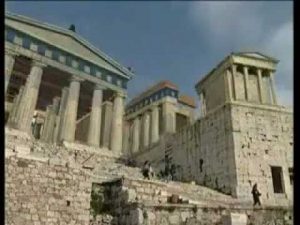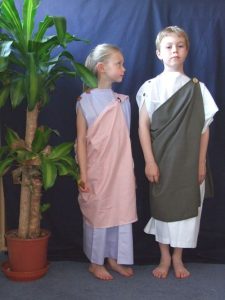Schools were not of much importance in Ancient Greece. References to schools of Ancient Greece were very scanty. Even around 390 BCE, there were no permanent schools and no formal courses for such higher Ancient Greek Education. Schools in Ancient Greece were very small. They had only one teacher and about ten or twenty students, of course, only boys. The Greek schools of the Ancient world were not free and so only the rich and privileged could really afford to send their children to school. Thus the commoners and the middle classes hardly had a chance to give their sons the taste of school education.

The children did not need much school equipment as they had to learn everything by heart. When they needed to, they wrote on wooden boards covered with layers of wax. They used a wooden pen called a “stylus” with a sharp end for writing and a flat end for rubbing out. The wax was melted and reapplied from time to time. Thus there was no need for any extra school appliances and the boards and pens of the Ancient Greek period were much different from those of the present era refill pens and modern exercise books.
Next, the specific school education system of the two key city-states of Sparta and Athens have been discussed.
Education in Ancient Sparta
Sparta. as we know. was entirely a military state and all of their culture and even their civilization was based on the cult of the warrior. Every aspect of Spartan life was devoted to supporting the warriors. Like their society, the education system of the Spartans focused on raising and nurturing warriors.
In Sparta, elementary schools were rough. Spartan boys were sent to a boarding school at the age of 6. In Spartan schools, science or mathematics were not considered important subjects, students could hardly read even after they were out of school.
In the Ancient Greek educational system, school courses were very hard and often painful. Teachers mostly cared about raising good soldiers. Somewhere between the age of 18-20, Spartan males had to pass a difficult test of fitness, military ability, and leadership skills.

Any Spartan male who did not pass these examinations became a “Perioikos.” Boys were divided into packs led by older boys. They had to wrestle a lot and even fight with each other. They were taught to obey all orders and to be ready to endure all kinds of hardship. Girls in Sparta did not go to school but could participate in wrestling and gymnastics.
The education system prevalent in Sparta for the new warriors was known as “Agoge”, whose ultimate goal was to generate effective male soldiers who would participate in the Spartan army. Boys aged only 7 had to undergo rigorous training sessions and except for the firstborn male of any household, mandatorily had to attend the pieces of training. Until the age of 20, the students had to live in these groups and communities, after which they professionally joined the army. Each of the student groups had to choose its leaders and it was the leader who consulted with the rest of the folks to choose the 20-year-old who would become the instructor. The 20-year-old pupils were the most senior group who taught the smaller kids and it was their duty to properly guide the younger ones, before working for the next thirty years in the Spartan army.
The main aim was to turn the students into loyal soldiers and for that physical training was mostly the focus. Boxing, swimming, hunting, tracking, fishing, wrestling, throwing the discus, and javelin were skills that were not only useful on the battlefield but were also relevant in traveling. Building shelters, first aid, and eating habits on the road were also taught to them. The boys had to undergo certain tests before becoming graduates. They had to steal food without getting caught. It indicated that he was prepared to live on his own if required after he had become a soldier. If caught, he was not punished for stealing, but for getting caught. Once caught, they were often beaten by whips which were usually kept for the slaves.
Spartan women, along with the boys, were also educated. Calisthenics, wrestling, and gymnastics were taught to them. It was a belief that strong women would produce strong kids who in turn would become strong warriors. This was the primary motivation behind educating women. While the boys were on the battlefield, they were to run the household. Thus they had to be physically and mentally strong to protect the household from outside attacks. Apart from these, children were also taught to especially respect the elders and address them as fathers. Adults had to ensure that their children learned manners and they were entitled to scold unruly kids but not whip them.
Spartans embarked on a respectful society where everyone was taught to respect the individual.
Education in Ancient Athens
The schools in Athens were very different from the schools in Sparta. In ancient Athens, the purpose of education was to produce citizens trained in the arts and to prepare them for both peace and war. Before the fifth century BCE, almost all the schools were private. They were very small, with no more than 10 to 15 students.
The education of the Athenian youths was similar to those of the other Ancient Greek city-states but different from that of Sparta. The Head of the family or father provided the education. Till the age of 7, boys and girls grew with each other but after attaining 7 years of age, boys went to school, accompanied by an educator. Girls stayed back and learned cooking, music, reading, and writing from their mothers. Women did not undertake any profession and continued with household activities. They had no political rights and were as good as the slaves. Women of Athens suffered like all other Ancient Greek city-states, except Sparta and Minoan Crete.
Parents had to pay for the teachers who taught the students in their houses and 4 teachers- the “philologist”, the gymnast, the music teacher, and the choreographer gave the basic education to the kids. Homer and Hesiod’s poetry along with the music were considered important elements of education. Men who had musical knowledge were considered to be educated. Children were taught specifically to play the lyre, which was the precursor to lyrical poetry.

Ancient Greek Education: Private Tutors
The Ancient Greek schools were mostly owned by certain private tutors. But the problem with this practice was that they charged money and thus the process of receiving education became very selective. Only the rich and wealthy sections of the population could afford such education. Thus it was limited to “the few.” It was only in the fourth century BCE that in some cities of Ancient Greece, public schools were opened where was education was made available for the poor and marginalized sections of the society.
Primary School
In Ancient Greece, the boys of the city-states started to go to school around the age of 7. Apart from reading and writing, they were also given lessons in music and physical training. From the age of 6, till they became 14-year-olds, they had to go to a neighborhood primary school or to a private school to receive a quality education. Books were not much in use and were highly expensive and even rare. Thus the boys had to memorize most of the things, if not everything. The Athenian girls never went to school.
In primary school, the students had to learn two important things – the works of Homer, a famous Ancient Greek epic poet (famous for the “Iliad” and the “Odyssey”), and how to play the lyre.